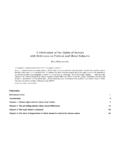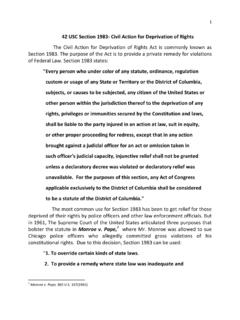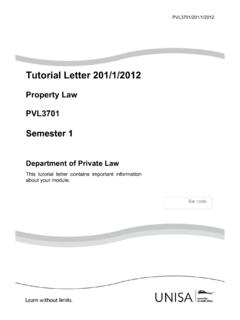Transcription of FEMINISM, LIBERAL. Emphasizing equal individual rights and ...
1 FEMINISM, LIBERAL 333. "Thinking Sex: Notes for a Radical Theory of the Politics of Sexuality." In Carole S. Vance, ed., Plea- sure and Danger: Exploring Female Sexuality. London: Routledge and Kegan Paul, 1984, 267-319. Reprinted in Henry Abelove, Michkle Aina Barale, and David Halperin, eds., The Lesbian and Gay Studies Reader. New York: Routledge, 1993, 3-44; and Peter M. Nardi and Beth E. Schneider, eds., Social Perspectives in Lesbian and Gay Studies. New York: Routledge, 1998, 100-133; Rubin, Gayle. "The Traffic in Women: Notes on the 'Political Economy' of Sex.
2 " In Rayna Reiter, ed., Toward an An- thropology of York: Monthly Review Press, 1975, 157-210. Reprinted in Linda Nichol- son, ed., The Second Wave: A Reader in Feminist Theory. New York: Routledge, 1997,27-62; Segal, Lynne, and Mary McIntosh, eds. Sex Exposed: Sexuality and the Pornography Debate. New Brunswick, : Rutgers University Press, 1993; Smith, Barbara, and Beverly Smith. "Across the Kitchen Table: A. Sister-to-Sister Dialogue." In Gloria Anzaldfia and Cherrie Moraga, eds., This Bridge Called My Back: Writings by Radical Women of Color.
3 New York: Kitchen Table, 1981, 113-27; Snitow, Ann, Christine Stansell, and Sharon Thompson, eds. Powers of Desire: The Politics of Sexuality. New York: Monthly Review Press, 1983; Stein, Arlene, ed. Sisters, Sexperts, and Queers: Beyond Lesbian Nation. New York: Plume, 1993; Trujillo, Carla Mari, ed. Chicana Lesbians: The Girls Our Mothers Warned Us About. Berkeley, Calif.: Third Woman Press, 1991; Wittig, Monique. The Lesbian Body. Trans. David Le Vay. Boston, Mass.: Beacon Press, 1973; Young, Iris Marion. Throwing Like a Girl and Other Es- says in Feminist Philosophy and Social Theory.
4 Bloornington: Indiana University Press, 1990; Zim- merman, Bonnie, and Toni A. H. McNaron, eds. The New Lesbian Studies: Into the Twenty-First Century. New York: Feminist Press at CUNY, 1996; Zita, Jacquelyn N. Body Talk: Philosophical Re- flections on Sex and Gender. New York: Columbia University Press, 1998. FEMINISM, LIBERAL. Emphasizing equal individual rights and liberties for women and men and downplaying sexual differences, liberal feminism is the most widely accepted social and political philosophy among feminists. Liberal feminists defend the equal ration- ality of the sexes and emphasize the importance of structuring social, familial, and sexual roles in ways that promote women's autonomous self-fulfillment.
5 They emphasize the sim- ilarities between men and women rather than the average differences between them, attrib- ute most of the personality and character differences between the sexes to the social construction of gender, and tend to promote a single set of androgynous virtues for both women and men. While rejecting strong claims of sexual difference that might underwrite different and potentially hierarchical rights and social roles, liberal feminists otherwise avoid the promotion of particular conceptions of the good life for either men or women, in- stead defending a broad sphere of neutrality and privacy within which individuals may pursue forms of life most congenial to them.
6 While liberal feminists acknowledge that some choices made by women are questionable because conditioned by sexist social prac- tices, they also tend to avoid maternalism and any second-guessing of those choices made without coercion,or threats. Fully informed and mentally competent adult women are as- sumed to be the final judges,of their own best interests. Thus liberal feminists tend to resist legislative intervention that would gainsay the judgment of women. The preeminence of this perspective owes much to the fact that it encompasses a wide range of related but distinct views that fit comfortably within the framework of political liberalism.
7 It does not fundamentally challenge capitalism or heterosexuality; nor does it recommend separatism, as do more radical feminists. Instead, it aims to extend the full range of freedoms in a liberal democratic society to women, criticizing practices that deny women equal protection under the law as well as laws that de facto discriminate against women. Liberal feminists reject utopian visions of an ideal society in favor of one that eliminates coercion and promotes autonomous choices among all its citizens. 334 FEMINISM, LIBERAL. With regard to sexuality, liberal feminism maintains the tradition of liberalism, valuing some B.
8 Personal privacy and autonomy in ways that appear, to some, to conflict with the goal of nism ex eradicating sexist norms. For example, liberal feminists tend to adopt a libertarian or pub- works c lic health approach regarding commercial sexual many liberal feminists re- Women ject calls to criminalize or even condemn prostitution and pornography when those who journali participate in their manufacture and consumption do so without coercion. They defend this had a p position by citing privacy but also by invoking the inherent value of autonomous choice.
9 Vote ant Liberal feminists defend the liberty to decide on one's sexual orientation, partners, and law. Hc practices as beyond the reach of law. They s~. Liberal feminism has its roots in the writings of, among others, Mary Wollstonecraft encing (1759-1797), John Stuart Mill (1806-1873), and Harriet Taylor Mill (1807-1858). Many tending writers prior to Wollstonecraft, such as Jean-Jacques Rousseau (17 12-1778), had explic- person2. itly argued that men and women were by nature not merely different in kind but different volved in "natural rank,'' with women being weaker physically, intellectually, and emotionally life anc (358-61).
10 Men were said to be more rational, women more emotional; their respective educa- Friec tions should reflect these differences. A few philosophers, such as John Locke (1632-1704), that als had argued that the sexes should receive the same education and that they shared equal not abc rights and responsibilities with respect to their children (see Some Thoughts, 14; Two Trea- erosexi tises, 303). Nonetheless, these writers stopped short of defending complete sexual equality mistak~. (either for social roles or legal rights ), and putative sex differences have been, and in some later c.





